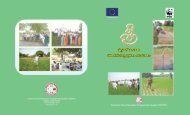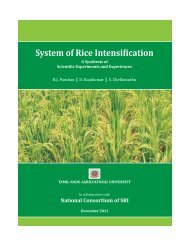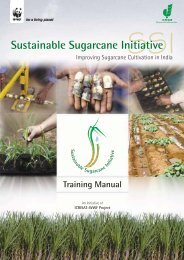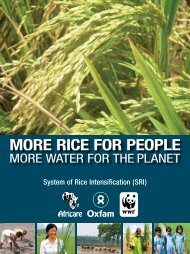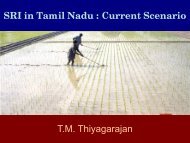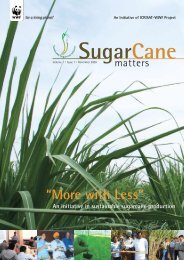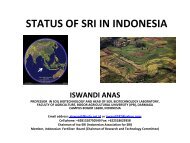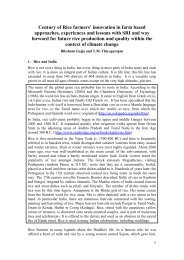SRI in Orissa - Cornell International Institute for Food, Agriculture ...
SRI in Orissa - Cornell International Institute for Food, Agriculture ...
SRI in Orissa - Cornell International Institute for Food, Agriculture ...
Create successful ePaper yourself
Turn your PDF publications into a flip-book with our unique Google optimized e-Paper software.
Box 6.1: How a progressive farmer learnt about <strong>SRI</strong> through SHGs<br />
Mr. Deepak Mahanta is an educated progressive farmer of Kerkera village. <strong>Agriculture</strong> Department, Government of <strong>Orissa</strong> had selected him to take<br />
part <strong>in</strong> a ‘Farmers to Farmers Tra<strong>in</strong><strong>in</strong>g Programme’ organised at Central Rice Research <strong>Institute</strong>, Cuttack. Now he is a tra<strong>in</strong>er on advance farm<strong>in</strong>g<br />
<strong>in</strong> that locality. He was also <strong>in</strong>cluded <strong>in</strong> a team of 50 farmers, selected <strong>for</strong> an exposure visit to Tamil Nadu and Puducherry, which was arranged<br />
by Government of <strong>Orissa</strong> <strong>in</strong> 2003. He has 27 acres of land. Out of that 20 acres he cultivates and rest 7 acres are wasteland. S<strong>in</strong>ce 1991 he is<br />
actively <strong>in</strong>volved with agriculture. In the year 1998 he <strong>in</strong>troduced government seeds, chemical fertilisers and transplant<strong>in</strong>g method. Next year<br />
he transplanted 5.0 acres of land. He had got 90 qu<strong>in</strong>tals of paddy from 5 acres (4.5t/ha), which was the highest ever yield <strong>in</strong> his life by us<strong>in</strong>g<br />
conventional method. But he never heard of <strong>SRI</strong> from government officials. When his wife Kamala Mahanta became a member of Maa Saraswati<br />
SHG, Kerkera last year, he became close to PRADAN and to know about <strong>SRI</strong>. In the year 2006 he had done <strong>SRI</strong> <strong>in</strong> an area of one acre.<br />
The <strong>SRI</strong> demonstration <strong>in</strong> the year 2003 (Kharif) was<br />
done <strong>in</strong> four different locations with different varieties.<br />
Bhr<strong>in</strong>garajpashi, Kadadiha, Tala Ka<strong>in</strong>isari and Gouda<br />
Champei were the villages where <strong>SRI</strong> demonstration was<br />
done. Non-HYV varieties like Konark, Surendra, Khandagir,<br />
Nab<strong>in</strong>, Swarnai and Lalat were then taken up. For <strong>SRI</strong> paddy<br />
only medium land is chosen, as up land and low lands seem<br />
to be not suitable <strong>for</strong> <strong>SRI</strong> paddy.<br />
<strong>SRI</strong> as an Opportunity to Double<br />
Productivity<br />
PRADAN sees <strong>SRI</strong> as an opportunity to double productivity<br />
and seems to be provid<strong>in</strong>g farmers’ food security <strong>for</strong><br />
8-12 months. The yields of <strong>SRI</strong> are an impressive 6-8 t/ha<br />
(Table 6.4).<br />
The highest number of tillers was 80 per hill and the rate<br />
of conversion to effective tillers 40%- 70%. As tiller<strong>in</strong>g<br />
goes up, the percentage of effective tillers comes down.<br />
Application of chemical fertilizer <strong>in</strong>creases the effective<br />
tillers. The number of bold gra<strong>in</strong>s per panicle was 150 –<br />
220 as opposed to 100-140 <strong>in</strong> the conventional method is.<br />
<strong>SRI</strong> plants are healthier than conventional and withstand<br />
longer dry spells. The fodder is almost three times more<br />
than the conventional paddy. The average yield recorded<br />
is shown <strong>in</strong> the Table 6.4. Though it fluctuates it is seen <strong>in</strong><br />
a majority fields the yield is 6.5 t/ha (2003-2006).<br />
The results shown <strong>in</strong> Figure 6.1 were recorded <strong>in</strong> Ekghari<br />
village under Kerkera gram panchayat of Karanjia block.<br />
Table 6.3: Spread of <strong>SRI</strong> through PRADAN<br />
<strong>in</strong> <strong>Orissa</strong><br />
Year Season Families Area (ha)<br />
2003-04 Kharif 4 0.2<br />
2004-05 Kharif 5 0.5<br />
Rabi 3 0.3<br />
2005-06 Kharif 130 13.0<br />
Rabi 25 2.1<br />
2006-07 Kharif 1050 105.0<br />
Rabi 25 0.36<br />
Table 6.4: Year-wise <strong>SRI</strong> outreach <strong>in</strong> <strong>Orissa</strong> and<br />
average yield<br />
Year No. of No. of Families Area (ha) Average Yield (t/ha)<br />
Districts<br />
2003 2 4 0.2 6.5<br />
2004 2 8 0.8 6.0<br />
2005 3 155 15.1 8.0<br />
2006 4 1075 105.36 6.5<br />
Fig. 6.1: <strong>SRI</strong> results growth status on<br />
31st May 2007 at Ekghari<br />
(variety-Nab<strong>in</strong>)<br />
Traditional, 10<br />
Improved, 18<br />
<strong>SRI</strong>, 50<br />
Average no.<br />
of tillers<br />
Traditional, 5<br />
Improved, 10<br />
<strong>SRI</strong>, 30<br />
Average no.<br />
of panicles<br />
Traditional, 90<br />
Improved, 140<br />
<strong>SRI</strong>, 130<br />
Average no.<br />
of gra<strong>in</strong>s<br />
Traditional, 75<br />
Improved, 85<br />
<strong>SRI</strong>, 95<br />
Average Height<br />
(<strong>in</strong> cm)<br />
For wide dissem<strong>in</strong>ation and popularization of <strong>SRI</strong><br />
methods of cultivation, PRADAN is tak<strong>in</strong>g up many<br />
approaches like conduct<strong>in</strong>g agricultural tra<strong>in</strong><strong>in</strong>g<br />
programs, organiz<strong>in</strong>g exposure visits, and proper follow<br />
up and guidance <strong>in</strong> the field. Hands on tra<strong>in</strong><strong>in</strong>g and<br />
support to SHG families through VLE (Village Level<br />
Expert) or SP (Service Provider) are be<strong>in</strong>g provided.<br />
The experts of PRADAN also supervise the <strong>SRI</strong> fields.<br />
Weeders have been provided by PRADAN to the farmers.<br />
PRADAN is also demonstrat<strong>in</strong>g and sensitiz<strong>in</strong>g women<br />
SHG members through guided exposure. Farmers were<br />
Expand<strong>in</strong>g Pro-poor Livelihoods through <strong>SRI</strong>: PRADAN’s Experiences <strong>in</strong> <strong>Orissa</strong> 45



